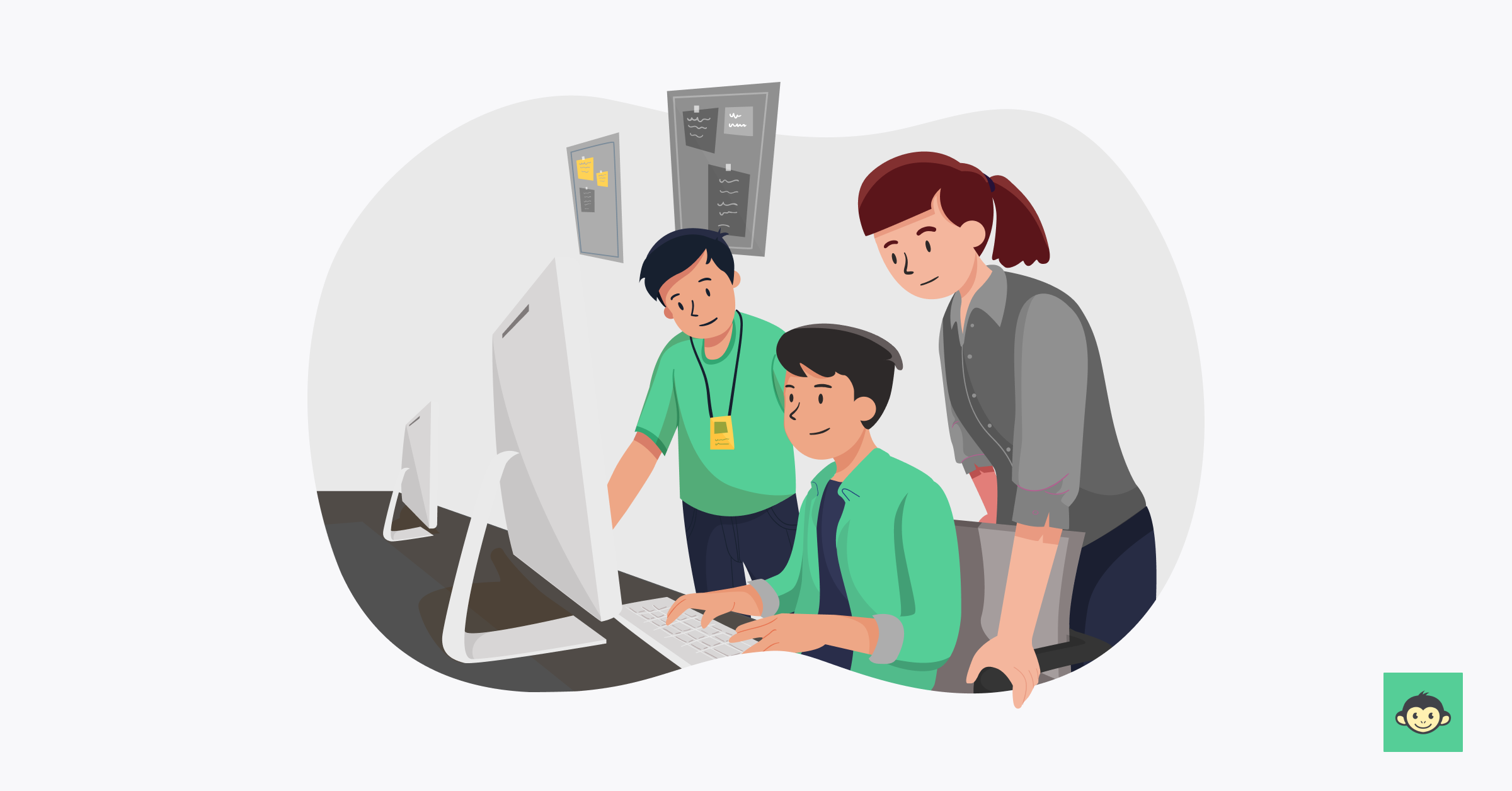Employee experience strategy: Definition & best practices

Imagine a workplace where employees are motivated, inspired, and fully engaged, resulting in higher productivity, lower turnover, and exceptional business outcomes. Sounds like a dream, right? Well, it's not merely wishful thinking.
Welcome to the world of employee experience strategy, where organizations prioritize the well-being and satisfaction of their employees to unlock their true potential. According to a recent study by Gallup, companies with highly engaged employees outperform their competitors by 147%.
This statistic alone highlights the critical role that an employee's experience plays in driving organizational success. In this blog, we will delve into the fascinating realm of employee experience strategy, exploring its definition, best practices, and actionable insights to create a workplace where employees thrive and organizations flourish. So, let's embark on this journey to unlock the full potential of your workforce.
What is employee experience?

Employee experience refers to the cumulative interactions, perceptions, and feelings that employees have throughout their employee journey with an organization. It encompasses every touchpoint and interaction an employee has with their work environment, including their physical workspace, colleagues, leaders, company culture, policies, and processes.
An employee's experience goes beyond traditional notions of employee engagement and focuses on creating a holistic and positive experience for employees throughout their employment lifecycle.
It involves understanding and addressing employees' needs, expectations, and aspirations to create a work environment that promotes their well-being, satisfaction, and productivity. Employee experience recognizes that employees are not just passive recipients of their work environment but active participants who contribute their skills, talents, and creativity to the organization's success.
A positive experience fosters a sense of belonging, purpose, and fulfillment, leading to higher levels of engagement, employee retention, and performance. It involves creating a supportive and inclusive culture, providing opportunities for growth and development, enabling work-life balance, and ensuring effective communication and collaboration.
Ultimately, an experience strategy aims to create an environment where employees feel valued, motivated, and empowered to do their best work, resulting in a win-win situation for both employees and the organization.
What determines employee experience?

Employee experience is a culmination of various factors that shape the overall happiness and satisfaction of employees in the workplace. Let's dive into the five key components that contribute to a cheerful experience:
Physical environment
A vibrant and comfortable physical workspace can significantly impact employee well-being and productivity. Bright colors, ergonomic furniture, natural lighting, and well-designed spaces foster positivity and creativity.
Company culture and values
A positive company culture that promotes trust, respect, collaboration, and recognition creates a sense of belonging. When employees align with the organization's values and feel appreciated for their contributions, they experience higher job satisfaction.
Growth and development
Career growth opportunities for learning, skill enhancement, and career advancement are vital for employee engagement. Providing training programs, mentoring, and clear pathways for growth not only nurture talent but also show employees that their development is valued.
Work-life balance
Striking a healthy balance between work and personal life is crucial for employee well-being. Flexible working hours, supportive policies, and initiatives that promote work-life integration contribute to reduced stress levels and increased job satisfaction.
Effective communication
Transparent and open communication channels facilitate collaboration, foster trust, and strengthen relationships. Regular feedback, clear expectations, and inclusive decision-making processes ensure that employees feel heard and valued.
By focusing on these components, organizations can create an environment that fosters happiness, engagement, and productivity. Remember, a cheerful employee experience sets the stage for success, fueling innovation, loyalty, and organizational growth. Let's embark on this journey to build an extraordinary employee experience together!
What is an employee experience strategy?

An employee experience strategy is a comprehensive plan and approach designed to create a positive, engaging, and fulfilling work environment for employees. It involves aligning organizational practices, policies, and initiatives to enhance employee satisfaction, well-being, and productivity.
An effective employee experience strategy recognizes that happy and engaged employees drive business success, and it focuses on fostering a culture that values and supports employees throughout their journey with the organization.
What are the 7 stages of employee experience?

1. Attraction
This stage focuses on creating a positive employer brand and attracting talented individuals to join the organization. It involves showcasing a compelling company culture, values, and benefits to attract the right candidates.
2. Recruitment and onboarding
Once the candidates are selected, this stage involves providing a smooth onboarding process that sets the tone for their employee's experience.
Clear communication, comprehensive training, and support during the initial integration help new employees feel welcomed and connected. Some companies, for example, create structured Jira onboarding templates to guide new employees through their first tasks.
3. Engagement
This stage revolves around creating an engaging work environment where employees feel motivated, committed, and connected to their work and the organization. It involves fostering open communication, recognition programs, and opportunities for personal and professional growth.
4. Development and learning
Investing in employees' growth and development is crucial for their long-term satisfaction and success. This stage focuses on providing continuous learning opportunities, skill development programs, and career advancement paths to support their professional journey.
5. Well-being
Employee well-being encompasses both physical and mental health. Organizations at this stage prioritize work balance, health benefits, wellness programs, and initiatives that support employee well-being.
6. Rewards and recognition
Recognizing and rewarding employees' contributions and achievements is essential for their motivation and job satisfaction. This stage involves implementing effective performance management systems, providing regular feedback, and offering meaningful rewards and recognition programs.
7. Offboarding
The final stage of the employee experience focuses on creating a positive offboarding process for employees leaving the organization. It involves conducting exit interviews, maintaining relationships, and providing support during the transition to ensure a positive last impression.
By strategically addressing each of these stages, organizations can create a comprehensive employee experience strategy that promotes a fulfilling and joyful journey for their employees.
How to implement a successful employee experience strategy?

Define clear objectives
Start by establishing clear objectives for your employee experience strategy. Identify what you want to achieve and how it aligns with your organization's goals. Ensure that your objectives are specific, measurable, achievable, relevant, and time-bound (SMART). Create employee journey maps to this effect.
Conduct employee feedback and assessment
Gather insights from your employees to understand their current experience. Conduct surveys, focus groups, or interviews to gather feedback on their needs, pain points, and suggestions. Use this data to identify areas for improvement and shape your strategy accordingly.
Align with organizational values
Ensure that your employee experience strategy aligns with your company's mission, vision, and values. Consistency between your company culture, values, and the employee experience is crucial for creating an authentic and meaningful workplace environment.
Design a holistic approach
Take a holistic approach to employee experience by considering all aspects of the employee journey. Focus on elements such as the hiring process, onboarding, learning and development, communication, work-life balance, rewards and recognition, and offboarding. Develop initiatives and practices that address each stage of the employee lifecycle.
Empower leaders and managers
Provide training and support to leaders and managers to enable them to effectively champion the employee experience strategy. Encourage them to lead by example, communicate transparently, and create a supportive and empowering environment for their teams.
Foster collaboration and communication
Encourage open and transparent communication across all levels of the organization in every level of the employee journey. Implement channels and tools that facilitate collaboration, knowledge sharing, and employee engagement. Regularly communicate updates, initiatives, and progress related to the employee experience strategy to keep employees informed and engaged.
Prioritize employee well-being
Make employee well-being a top priority. Implement policies, programs, and initiatives that promote work-life balance, mental health support, wellness activities, and a positive physical work environment. Show genuine care and support for your employees' overall well-being. Take initiative to boost employee morale.
Continuously measure and adjust
Establish metrics and feedback mechanisms to assess the effectiveness of your employee experience strategy. Regularly collect and analyze data on employee engagement, satisfaction, retention, and performance. Use this information to make necessary adjustments and improvements to your strategy over time.
Foster a culture of continuous improvement
Employee experience is an ongoing journey. Encourage a culture of continuous improvement by seeking feedback, evaluating results, and incorporating new ideas and best practices. Regularly revisit and refine your strategy to ensure its relevance and effectiveness.
Remember, successful implementation of an employee experience strategy requires commitment, leadership support, and a genuine focus on creating a positive and engaging workplace environment. By investing in your employees' experience, you can foster a thriving workforce that drives organizational success.
Employee experience strategy examples

Employee development initiatives
Providing opportunities for skill development, career advancement, and continuous learning through workshops, training programs, mentorship, and tuition reimbursement.
Recognition and rewards programs
Establishing systems to acknowledge and appreciate employee contributions, including employee-of-the-month awards, peer recognition platforms, and performance-based bonuses.
Communication and feedback channels
Creating transparent communication channels, such as regular team meetings, suggestion boxes, employee surveys, and open-door policies, to foster two-way communication and address employee concerns.
Collaborative and inclusive culture
Encouraging teamwork, diversity, and inclusion through cross-functional projects, employee resource groups, diversity training, and initiatives that promote a sense of belonging.
Common mistakes in implementing an employee experience strategy

Lack of leadership support
Insufficient backing and involvement from leadership can hinder the successful implementation and adoption of employee experience initiatives.
Inadequate employee involvement
Neglecting to involve employees in the decision-making process or failing to seek their feedback and input can lead to initiatives that don't resonate with their needs and preferences.
Inconsistent implementation
Inconsistencies in implementing the strategy across departments or locations can result in a fragmented employee experience and lack of alignment with organizational goals.
Failure to measure and adapt
Not establishing metrics or regularly evaluating the impact of employee experience initiatives can hinder the ability to identify areas for improvement and make necessary adjustments.
Neglecting continuous improvement
Employee experience strategies require ongoing assessment and refinement. Failing to continuously seek feedback, address emerging challenges, and evolve the strategy can hinder its long-term effectiveness.
6 Employee experience best practices to follow

1. Prioritize employee voice
Actively listen to employees' feedback, concerns, and ideas. Encourage open communication channels and create opportunities for employee input in decision-making processes.
2. Foster a positive work environment
Cultivate a culture of respect, collaboration, and inclusivity. Promote teamwork, recognize and appreciate employee contributions, and ensure fairness and equity in policies and practices.
3. Provide growth opportunities
Support employees' professional development through training programs, mentorship, and career advancement opportunities. Help them acquire new skills and knowledge to progress in their careers.
4. Enhance work-life balance
Promote work-life balance by offering flexible work arrangements, promoting mental and physical well-being, and encouraging employees to take time off to recharge and maintain a healthy work-life integration.
5. Streamline employee processes
Simplify administrative tasks and provide efficient tools and technologies to streamline workflows. Reduce bureaucracy and eliminate unnecessary barriers that hinder productivity and engagement.
6. Continuously measure and improve
Regularly assess employee satisfaction, engagement, and well-being through surveys and feedback mechanisms. Use data-driven insights to identify areas for improvement and implement necessary changes.
How can an employee experience platform help you implement a positive employee experience strategy?

An employee experience platform is a technology solution designed to enhance and streamline various aspects of the employee experience. It can assist in implementing an employee experience strategy by:
Centralizing communication
An employee experience platform provides a centralized hub for communication, ensuring consistent and transparent messaging across the organization. It enables efficient sharing of information, updates, and important announcements.
Enabling collaboration
These platforms facilitate collaboration among employees, teams, and departments. They offer features such as project management tools, document sharing, and real-time collaboration, fostering teamwork and improving productivity.
Supporting feedback and recognition
Employee experience platforms often include tools for feedback collection and recognition. They enable employees to provide feedback, participate in surveys, and receive recognition for their contributions, promoting a culture of appreciation
Automating workflows
By automating routine tasks and workflows, employee experience platforms help reduce administrative burdens, freeing up time for employees to focus on more meaningful work. This improves efficiency and allows employees to dedicate their energy to value-added activities.
Offering learning and development resources
Some employee experience platforms provide access to learning and development resources, including online courses, training materials, and skill-building modules. This supports employees' growth and development within the organization.
Data analytics and insights
Employee experience platforms often offer analytics and reporting functionalities. They provide valuable data and insights on employee engagement, satisfaction, and performance, enabling organizations to measure the effectiveness of their initiatives and make data-driven decisions.
Conclusion
Implementing an effective employee experience strategy requires prioritizing employee well-being, fostering a positive work environment, and providing opportunities for growth and development.
Leveraging an employee experience platform can streamline communication, collaboration, feedback, and recognition processes, enhancing the overall employee experience. By following best practices and leveraging the right tools, organizations can create a thriving and engaged workforce that contributes to their success.
Ready to enhance employee experience strategy? Explore the power of CultureMonkey, an engagement platform designed to boost workplace culture, measure employee sentiment, and drive positive change.
Visit CultureMonkey today to revolutionize your employee experience and unlock the full potential of your organization. Unleash the full potential of your business with tailored employee feedback surveys.
FAQs
What is the difference between employee experience and employee engagement?
Employee experience refers to the overall journey and perception of employees within an organization, while employee engagement specifically measures their level of commitment, motivation, and involvement in their work.
How can organizations measure employee experience?
Organizations can measure employee experience through surveys, feedback mechanisms, focus groups, and analyzing metrics such as employee satisfaction, engagement levels, turnover rates, and productivity.
What role does leadership play in employee experience?
Leadership plays a crucial role in shaping employee experience by setting the tone, defining the culture, providing support and guidance, and creating an environment that promotes employee well-being and engagement.
How can employee experience impact organizational performance?
A positive employee experience can lead to higher employee satisfaction, increased engagement, improved productivity, enhanced customer service, higher retention rates, and a positive impact on the overall organizational performance.
Can small businesses implement employee experience strategies?
Yes, small businesses can implement employee experience strategies by focusing on areas such as communication, recognition, growth opportunities, work-life balance, and fostering a positive work culture, even with limited resources.



